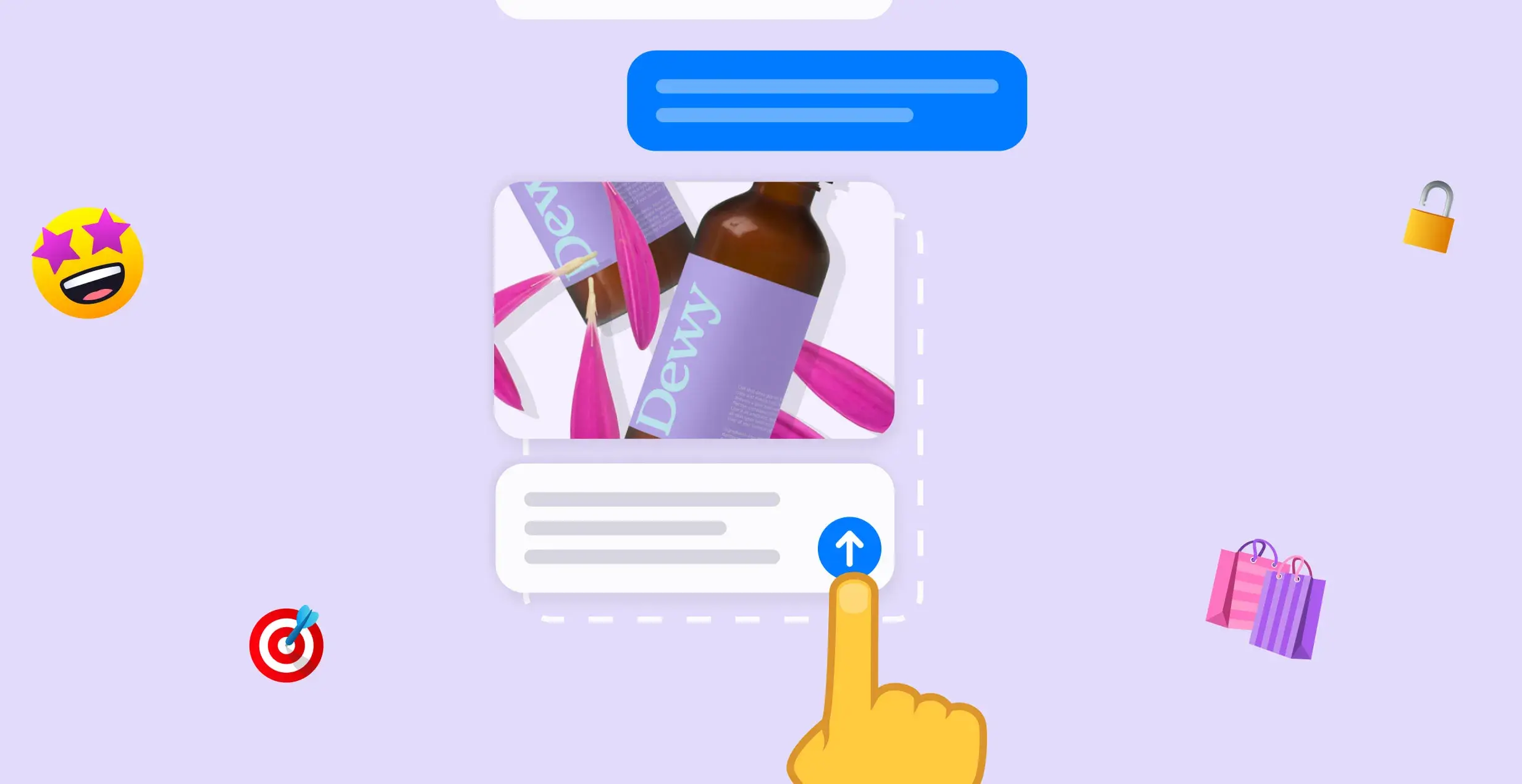
SMS Marketing: An Intro to Marketing with Text Messages [2022]
Introduction: What is SMS marketing and who uses it?
SMS marketing has been around for awhile, but it gained a lot of attention—and adoption—as a result of the COVID-19 pandemic.
Unable to connect with customers in the usual, in-person manner, many businesses—restaurants, stores, and service providers—turned to text messaging and other mobile channels to stay in touch safely during a time of social distancing.
But even though stay-at-home orders have been lifted, consumer behavior has fundamentally changed. More communications and transactions are happening via smartphone. Customers have embraced the convenience of shopping and interacting with brands from the palm of their hand.
While Postscript caters specifically to ecommerce brands, SMS (short message service) marketing isn’t just for online merchants. While it is a natural transition from email marketing or paid advertising for brands who are digitally native, even B2B companies, brick-and-mortar stores, and hospitality services have found success on the SMS channel.
So, let’s broaden our view and get a thorough understanding of the rise of SMS, some general best practices, and guidelines for how all kinds of businesses are using text messaging as a way to communicate with customers.
In this article (click to jump to a specific section):
Why is SMS marketing becoming so popular?
Flash back to 10 years ago.
Following the 2009 recession, customers saw a decrease in direct mail from brands due to the expense associated with the channel—plus, people just weren’t shopping much anymore.
So, businesses looked to the next “cutting-edge” technology to promote their goods and services: email marketing. At the time, email marketing was only used by a select subset of retailers, so many considered it an experimental channel.
Now, almost every business uses email in some capacity—whether it's to market to new customers, send updates on transactions, get more followers on social media, or anything in between. From a promotional standpoint, the channel is getting a bit crowded.
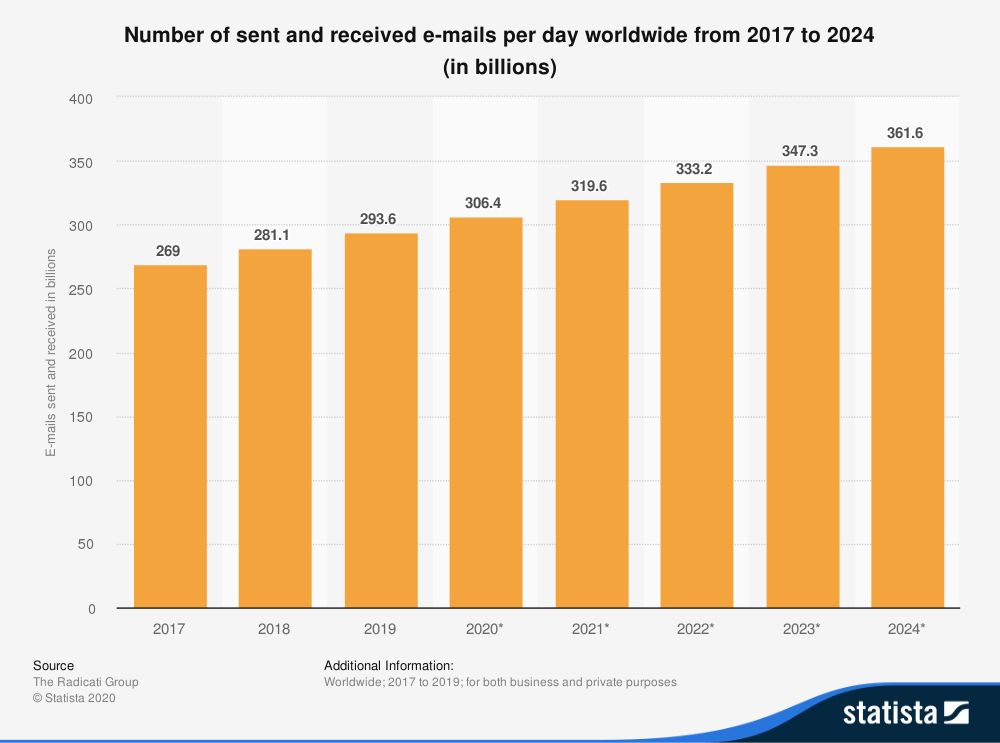
The number of emails sent every day continues to rise. Source: Statista
Consumers everywhere are being plagued by “inbox fatigue”—where they simply avoid the “promotions” tab of their email client because there is too much being sent to them.
SMS marketing still has a ways to go until we see a similar effect—and maybe we won’t see it at all, as long as marketers continue to treat SMS marketing as a personalized, nuanced, and intimate channel.
While email still has a place in many businesses—alongside paid advertising, wholesaling, and other established digital marketing strategies—there's no denying that everyone is looking for the next big thing. SMS marketing has technically been around since the 1990s, but this is the decade that it has risen to widespread popularity. That's because:
It meets customers where they are. More and more people are spending time on their phones.
Customers are becoming comfortable with being approached in the channel. Back in the early 2000s, an SMS marketing message from a brand was probably not a good idea, because people weren’t texting often. So, a text from a business would feel highly intrusive.
It’s a channel with proven success. With nearly 100% open rates and clickthrough rates that blast email and paid advertising out of the water (think 10% and more), SMS is winning the hearts of many marketers (when done effectively, that is).
So, you’re probably thinking—okay, how can I get my piece of the pie? And how much is it going to cost?
How much does SMS marketing cost?
The cost of SMS marketing includes a per-message cost—sometimes called a “credit”—and often a fixed cost for managed services and/or campaign creation.
This cost varies depending on the SMS marketing software you use, but expect to spend anywhere from $.009 to $.10 per message. That price may increase based on a few things:
Whether you’re paying an agency or service provider to manage SMS marketing on your behalf.
Whether your solution accounts for carrier fees or tacks on additional platform fees.
Whether you send more MMS than SMS (because MMS messages, which include images or GIFs, are more expensive to send).
Still, at just cents per message, SMS is a super affordable channel—especially if you’re taking the time to craft a more tailored approach with your campaigns.
How does list hygiene factor into ROI?
But the price of your SMS marketing depends a lot on how you manage your contact lists.
Get this: An enterprise company creating set-it-and-forget-it mass texts to hundreds of thousands of subscribers may see a significantly reduced ROI compared to a smaller brand that takes time to segment their list and only sends SMS marketing to people they know will convert.
List hygiene is important in any marketing channel—SMS included.
Compared to other channels, SMS is:
Similar in pricing to email marketing—marketers spend between $10-$1,000 on email marketing per month.
Much more affordable than direct mail, which comes with costs reaching up to $5 per piece depending on printing quality, volume, and shipping.
Low costs paired with the ability to get up close and personal with customers makes it no surprise that companies across the globe are starting to use SMS marketing as part of their regular go-to-market strategy.
Benefits of SMS Marketing
As with any other communication channel, the primary benefit of SMS marketing is the ability to communicate with your customers.
This communication can take on many different forms depending on your business and use cases—from transactional emails and order confirmations for commerce stores, to wait list notifications for restaurants.
In fact, basically any message you need to send to customers can be done through SMS.
At Postscript, we’ve seen it all. Here's an example of an SMS marketing campaign featuring a helpful infographic.

Emergency-preparedness tips sent from JUDY to customers
And here's one where a brand treated subscribers to a coffee out of the blue—no strings attached.

Free Starbucks gift cards (!!!) from Blume
And here’s the thing: neither of these messages included a link. That’s right—sometimes companies send SMS marketing messages without a clear intent or call to action. It's simply about creating memorable experiences and driving loyalty and retention.
SMS Marketing Metrics
If you do include a link, though, chances are you want to be able to track engagement with it—which brings us to SMS marketing metrics.
Average CTR for SMS Marketing
The CTR (clickthrough rate) for SMS marketing messages varies across industries, verticals, and message types.
For ecommerce in 2021, the CTR ranged between 7.5%-30.3%.

Find more statistics about SMS marketing in our SMS Benchmark Report.
For message types outside of ecommerce—like appointment confirmation requests or delivery updates—the CTR is likely much higher.
Average Open Rate for SMS Marketing
The average open rate for SMS marketing is between 98%–99%.
But SMS open rates are widely discounted as a vanity metric for a couple of reasons:
Open rates for text messages are hard to track.
Text messages are almost always opened by the end user—which is why they have a 99% open rate. That’s a compelling number, but not where your key focus should lie.
If you’re comparing the open rate of email marketing versus SMS marketing, SMS will come out on top (by far), but it is better to focus on a more conversion-driven metric like CTR or earnings per message (EPM).
Average EPM for SMS Marketing
The average EPM (earnings per message) for SMS marketing depends on your product’s price, the intent of your message, and the volume of texts you send.
According to our data, the mean EPM hovers around $4.50. But the more a customer has engaged with your brand, the more likely they are to purchase—which is why things like like abandoned cart messages typically generate more business.
Interestingly enough, we've found that messages with the lowest EPM came from customer winback campaigns.
Average SMS Unsubscribe Rate
The average unsubscribe rate for SMS messages ranges between 0.9% and 3.1%, again depending on the type of message being sent.
Welcome series have the highest unsubscribe rate, perhaps because customers aren’t exactly sure of what they’re signing up for when they opt into SMS marketing. (Making sure you explain this in your initial communication—like within the collection popup—solves for this and keeps your brand compliant.)
As for the lowest SMS unsubscribe rate, campaigns see the fewest number of people opting out. This makes sense, since campaigns are typically sent to customers who are already familiar with your brand and who have been subscribed to your SMS for awhile.
And contrary to popular belief, some unsubscribes are actually a good thing. They keep your marketing lists clean and ensure that you’re only sending messages to consumers who are actually interested in your products. That keeps your marketing spend low and your other metrics (like engagement and EPM) high.
Average SMS Send Volume (a.k.a. How often should you text customers?)
The average brand sends 1 SMS message per week.
This depends on the age of the subscriber.
When we looked at our customer data in September 2020, we found that stores sent promotional messages spaced 4 days apart on average during the first 10 days after subscriber opt-in, and then decreased to a consistent 7 to 9 days between promotional messages by the time subscribers are a month old. This amounts to 5–6 messages in the subscriber’s first month, and about 3–4 messages per month in the months thereafter.
The overall industry average varies between 2–6 texts per month, with the most successful brands sending at least 5 messages per month.
Important note: Based on our research, the most successful brands send every subscriber on their list a minimum of 5 texts per month.
This, of course, also changes for SMS marketing that is purely transactional, delivery-based, or notification-based. For example, meal delivery service Lunchdrop sends a text every weekday, because they’re asking you to select your meal—no follow-up needed.

Customers of transactional SMS have different expectations than customers of promotional SMS, so don’t expect this method to translate across different communication types.
Types of SMS Marketing messages
To the average shopper, one thought usually comes to mind when they think of SMS marketing: promotions.
But in truth, there are so many other use cases for the text messaging channel.
Every type of business transaction can be aided by SMS marketing.
But before we dive into all of the different types of text messages businesses can send, let’s make one quick distinction.
What’s the difference between SMS and MMS?
The difference between SMS and MMS messages is that MMS messages contain pictures, GIFs, or animations. SMS messages only contain copy (a.k.a. text).
When SMS marketing first came into the limelight, many people (including us!) thought it was best to use a picture in every text message. But now, data shows that SMS messages actually perform just as well, have fewer deliverability issues, and cost less to send.
In fact, Postscript often recommends that brands opt for SMS instead of MMS during high-volume times like BFCM.
What You Need to Know About Different Types of SMS Marketing
SMS marketing isn’t just another way to send deals to your customers. It’s a way to uplevel your customer experience with thoughtful touchpoints, transactional details, customer support, and more—in addition to occasionally letting subscribers know about an upcoming product launch or sale.
Much like any other marketing channel, SMS requires a thoughtful mix of messages that help your business meet its goals while also not annoying customers. Sound complicated? Let us help:
Some messages are promotional, and some are transactional.
This one’s pretty simple.
Some messages are sent with the intention of making customers purchase. Others are sent to give them a piece of information—like order confirmation or shipping updates.
Aside from message intent, another clear difference between promotional and transactional SMS revolves around compliance.
Compliance rules for transactional SMS are slightly more lenient due to the fact that transactional messages are informational and may be necessary for the customer to receive, regardless of whether they have subscribed to marketing communications.
Transactional SMS can be sent to any customers at any time of day, but promotional SMS must be sent during “waking hours”—in Postscripts’ case, that's 8:00 AM–11:00 PM EST for campaigns and 11:00 AM–9:00 PM EST for automations.
A strategic sending cadence is key to success.
We covered this a bit earlier, but when it comes to promotional SMS, savvy marketers know that “spray-and-pray” bulk SMS distribution approaches do nothing for your ROI. Full-list sends can be effective in some cases, but they should be mixed in with segmented campaigns, conversational messages, and behavior-based automations.
A great way to determine how many texts to send (and how often to send them) is to survey your customers to see what types of messages they’d like to receive.
The number you send from makes a difference.
There are two ways you can send SMS messages:
With a 5 or 6-character short code
With a 10-character long code
Short codes are better for SMS marketing. SMS marketing is considered “high-volume” sending, and many texts can be sent at once from a short code. With long codes, only one text can be sent per second.
Plus, when a consumer sees a text from a short code, they immediately know it is from a business trying to get in touch with them. While having a long code mimics the experience of texting with someone else on a mobile device, people actually don’t mind getting messages from short codes.
Carriers also hand-approve all short codes, so by using a short code you’re less likely to be filtered by carriers or suspended.
Plus, for those brands who want to use imagery in their text message marketing, SMS is your only bet. You cannot send MMS through a long code.
There are some nuanced circumstances in which a long code is better for your promotional texts—like if you truly need a one-on-one communication channel, or only anticipate sending a really small volume of messages. But usually your best option is a short code.
If you’re not compliant, you can get fined.
We mention SMS compliance in just about every piece of material we publish, so it may feel a bit repetitive, but we cannot stress it enough—if you’re not collecting phone numbers and sending SMS/MMS messages compliantly, you can put yourself out of business.
In the United States, the Telephone Consumer Protection Act (“TCPA”) and its accompanying regulations control how companies can use SMS and MMS text messaging services to communicate with customers and subscribers.
As a company sending SMS and MMS marketing, it is your responsibility to ensure that you understand and are complying with all relevant TCPA regulations.
To sum TCPA up, consumers have the right to not receive unsolicited marketing communications via SMS, and companies shouldn’t send SMS marketing to customers unless they have express written consent from the consumer.
This consent can be gathered electronically, and most likely is in an online scenario. A few compliant ways consumers can opt into SMS marketing include:
By texting a keyword
By signing up and inputting their phone number into your website
On a list at an event
As part of a giveaway
But no matter what type of opt-in you use, you have to make sure that there is explicit language stating that by signing up, the consumer agrees:
To receive recurring marketing messages at their mobile phone number
That your messages may involve the use of an automatic telephone dialing system (“ATDS”)
That consent is not a condition of purchase.
Here is an example of TCPA and CTIA-compliant language.
I agree to receive recurring automated text messages at the phone number provided. Consent is not a condition to purchase. Message & data rates may apply. Message frequency varies. Reply STOP to unsubscribe. Reply HELP for help. View our Terms of Service and Privacy Policy for details.
Compliance can be tricky, but it is something your brand needs to nail down unless you want to face serious fines—like up to $500 per message. That's a huge harm to your bottom line, especially for small businesses.
SMS Marketing Use Cases and Campaign Examples
The simplest way to understand how SMS marketing works for a variety of industries is to take a look at what is actually being done by different brands.
It’s easy to view SMS marketing as something that is exclusively used in a retail environment (i.e., brands use SMS to sell you stuff), but in reality SMS is being used just about everywhere.
Take a look at the 2020 US election. Chances are you received a few messages from people urging you to vote.
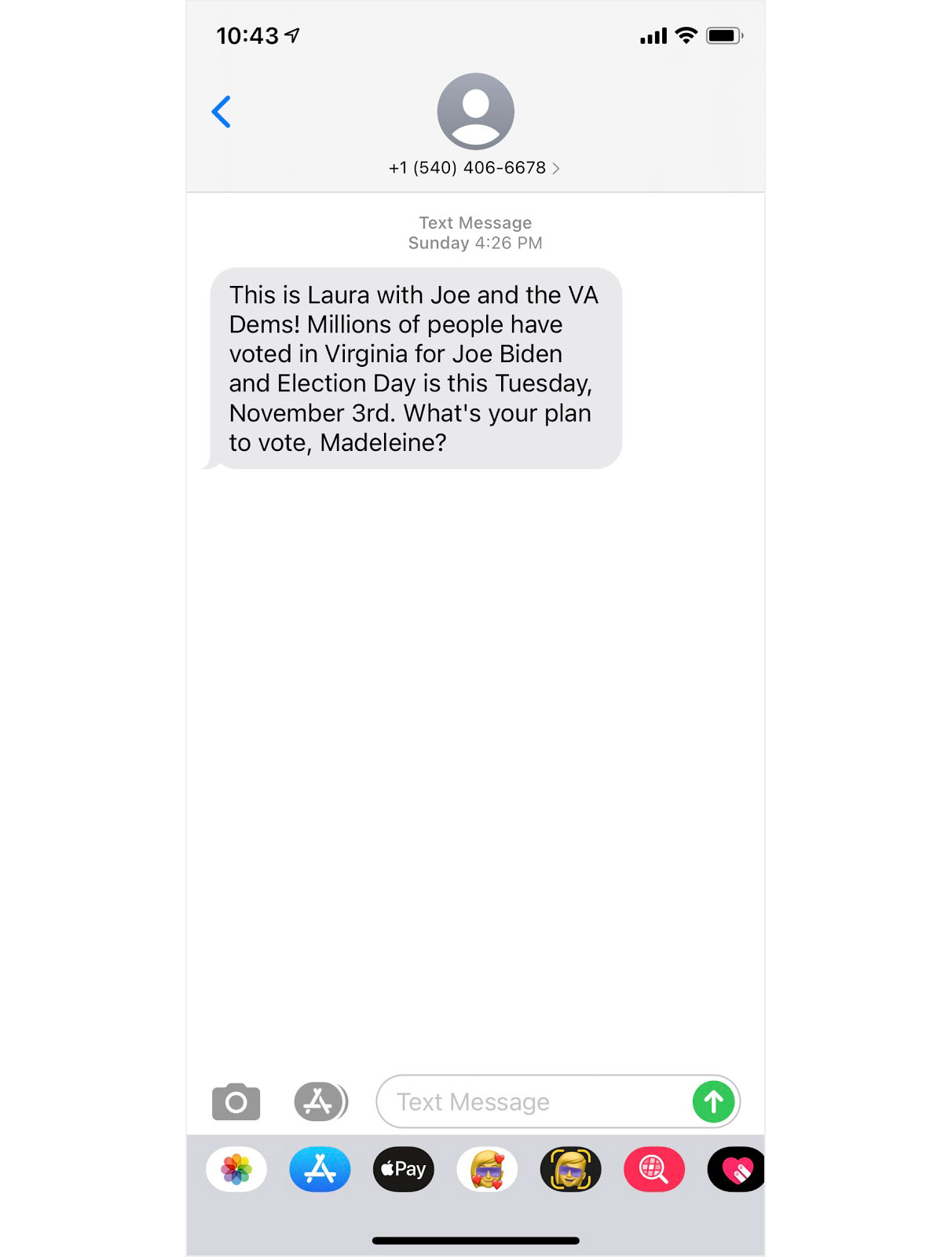
While the compliance—as well as the volume—of these messages is something to question, one thing is for sure: SMS has a practical use for a lot of different types of consumer communication.
Here is a pretty comprehensive list of where we’ve seen SMS in the wild.
Retail and Ecommerce
Perhaps the most common use case of SMS marketing, commerce stores use SMS as a marketing channel to communicate with customers in a number of ways.
One quick thing to note—not all of these are Postscript customers. While we’re the go-to SMS choice for many Shopify brands, often other technologies (or SMS platforms!) are a better fit for particular use cases.
Abandoned Cart SMS
When you’ve added a product to your cart and then abandoned ship—while also giving consent for SMS communications—brands will often send you a text reminding you (and incentivizing you) with a CTA to complete your order via an abandoned cart SMS.
Here’s one from Wodbottom.

Reply-to-buy
What’s easier than going back to a retail site and completing a purchase? Simply hitting “reply” and letting the brand do the work for you!
Here’s it in action by Hydrant, powered by Repeat.

Welcome Series
When a subscriber joins an SMS list, it’s common practice to welcome them with a special message. Here’s a good one from JUDY.

Cross-sell / Upsell
It’s all about the timing. If you haven’t purchased from a brand in awhile, they may send you a quick reminder of what you’re missing with a cross-sell or upsell SMS campaign—urging you to purchase again or try something new.
Sometimes they make the deal sweeter with a discount code.
Check out this example from Alpha Lion.

Promotional Campaigns
The simplest and most common campaign of all ecommerce SMS marketing is promotional—and it makes sense. Brands want customers to know about the products they sell.
Here’s one from Slumberkins.

Engagement / Brand-building
Sometimes, all it takes is a quick touch-base to make a customer feel happy. Not everything has to be about promotions, and some brands take this to heart by sending conversational text messages with no call to action.
What does this look like in real life? Take this example from Great Jones, a cookware brand. They have a “Potline” that you can text in asking for recipe ideas. This creates great brand awareness.

Transactional SMS Messages
These are a different breed of communication. Aside from the differences surrounding SMS compliance for transactional messages, they serve a different intent—instead of selling something, brands use transactional SMS to relay important information to consumers.
They are applicable in industries outside of ecommerce, as well.
Order Confirmation SMS
Whether you’re ordering a new pair of jeans, a set of binoculars, or some yummy Thai food, some brands will let you know that you’re all set via SMS. Here’s an example pulled straight from my phone from one of my favorite restaurants, Thai Fresh. If you're ever in Austin, check them out. 🤠

Shipment Notifications
If you’re like me, you’re constantly checking where your online purchases are in their journey to you. SMS makes it easier to keep track of what’s happening.
Here’s an example from Frey:

And one from Apple — you’ll also see delivery confirmation here, which is even better!

Delivery Notifications
Postal carriers like UPS and FedEx are notorious for giving SMS updates.

Sometimes small businesses put their own spin on this, as well, although it may be harder to scale.
When I did a pickup for a virtual cheese class from Antonelli’s (also a great spot in Austin), I went through a series of messages to help them figure out where I was parked.

Appointment Reminders
More and more appointments are being made online rather than over the phone. Sticking to the digital trend, offices now use SMS to confirm appointments with clients.
Here are a few different types of notifications from my hairdresser using Vagaro:

And a more simple variety from a physical therapy appointment.
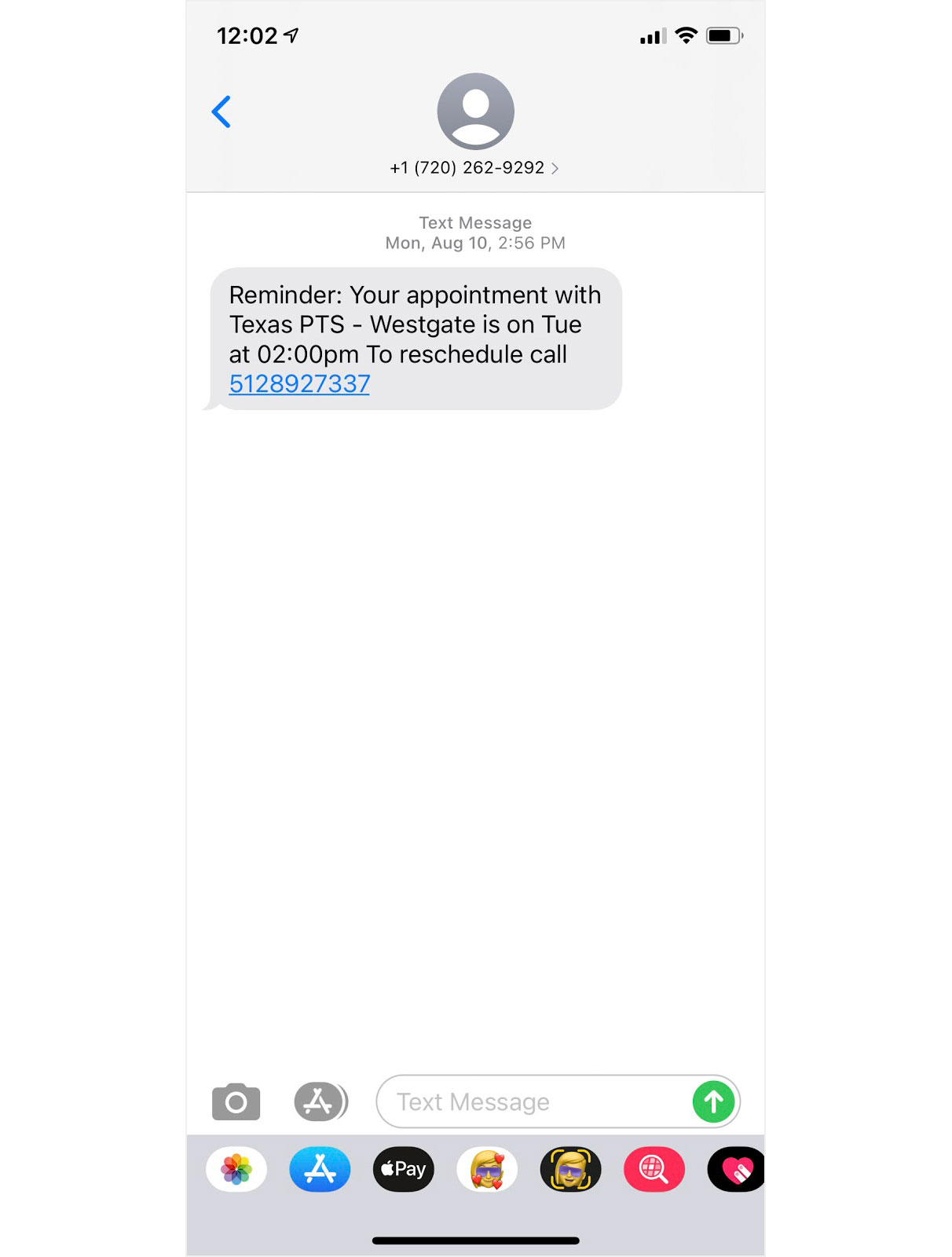
Whenever you implement mobile marketing into your channel mix, much like email, it’s really important to have a human at the other end of the line who is available to answer any questions that come through in real-time. If a customer has a question about an order, delivery, or something else, they expect to get communication back from you. If they don’t, it isn’t a good customer experience.
Customer Support
Here’s a great example from Maev.
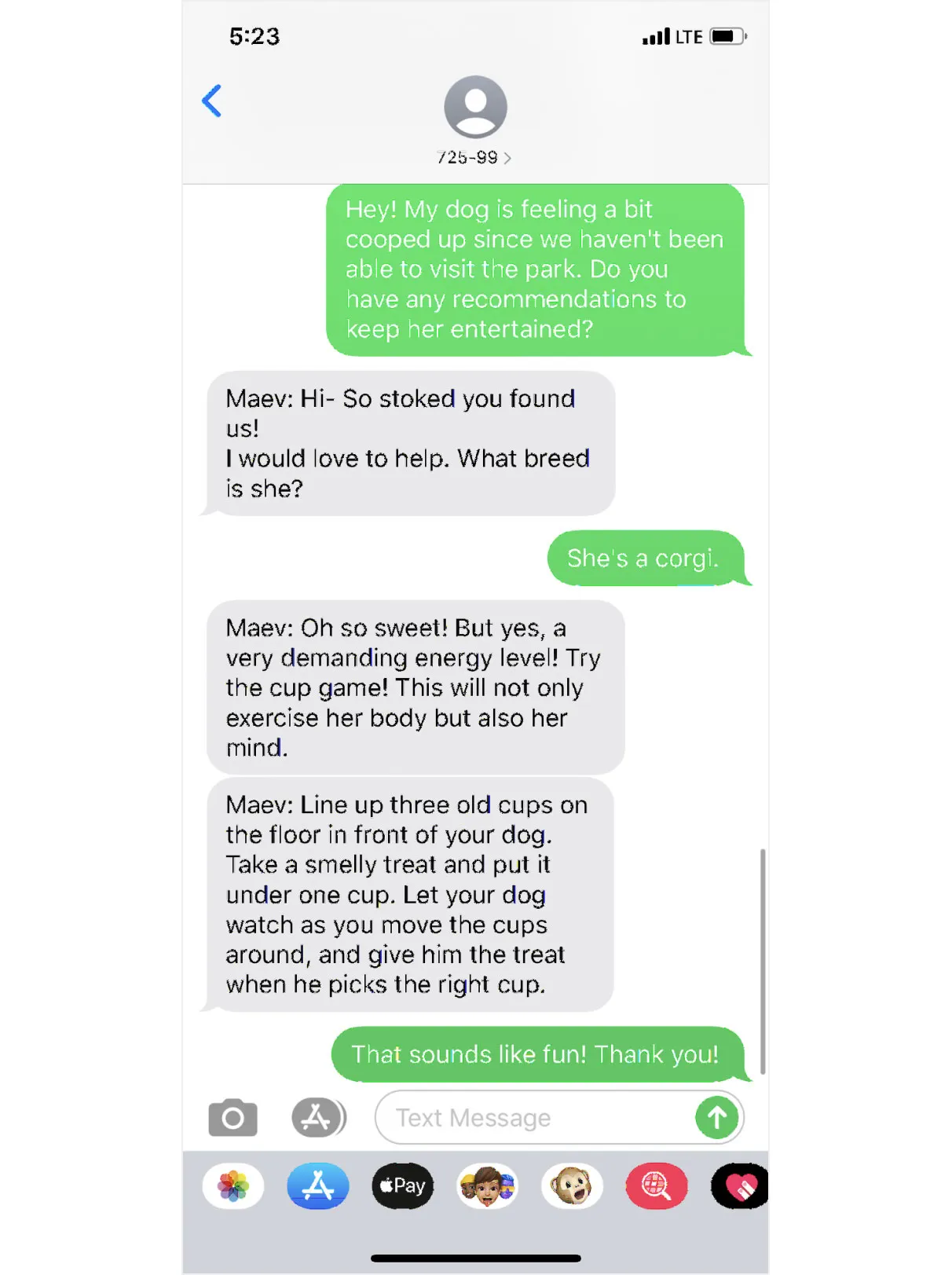
If you can’t afford to have someone dedicated to support (which you should prioritize), or if your platform doesn’t allow for two-way SMS chat, a good middle ground is putting up an autoresponder, like this:

Customer Loyalty Programs
Rewards programs have been around since the 1700s (yes, really), and for good reason—they are a great way to gain repeat customers.
Brands often use SMS as a way to remind customers about the number of points they have left to redeem—or to do a loyalty-related product launch (limited release drops for VIPs) or a loyalty-related promotion (double the points on your purchase this week).
Here’s a loyalty-related promotion from Girlfriend:

And a few others from a local CBD shop, MARYJAE.

There are also ecommerce brands who will ask for reviews via SMS.
SMS for Politics
Now more than ever, SMS is finding a place in the political environment, even though it’s been a bit overwhelming.

Pharmacy Notifications
View prescription status, refill notifications, and more. Here’s what I get from Walgreens.

Real Estate Notifications
We are seeing an increasing number of real estate and real estate related businesses start to use SMS for notifications about showings, open houses, estate sales, and more.
After inquiring on Zillow about a property, I received a drip campaign of text messages from a Zillow employee trying to get me connected with a local realtor.

And when I reserved a shopping window at a local estate sale, I got a reminder text about it on my phone the morning of.

Financial Services Notifications and Transactions
Card payment declined? Monthly payment due? Suspicious activity? Your bank can now let you know via SMS if anything is going on with your account.
Brex does this well, and lets you reply with additional details about the transaction (and yes, that was me spending $30 on coffee…):

But this is just a taste of the different use cases for SMS marketing. It seems like every week there is a new, innovative brand doing something different with texts. This list is likely to evolve really quickly.
Putting Together an SMS Strategy for Your Business
As we just saw, there are tons of different ways that businesses can use SMS.
Your SMS marketing strategy will change depending on what the goals of your SMS campaigns are. Here are a few quick tips to help you get started, but by no means is this a comprehensive strategy, because your brand's needs may be different from others.
SMS for Business Growth
If you’re using SMS to grow your business (the most common use case), make sure you start building your list from the get-go with keywords and on-site SMS collection popups.
From there, do segmentation. Try sending text messages to consumers you know will purchase, either based off of on-site activity (like cart abandonment) or patterns in their purchase activity (they seem to buy every 3 months).
Don’t be afraid to get more personal with SMS by offering customer support or two-way chat, either. The most talked-about brands using SMS often have a really innovative approach.
SMS for Customer Service
As always, you want to underpromise and overdeliver. Much like consumers are often disappointed by on-site chat experiences where there is no one to interact with, if you boast about SMS customer support, you need to have a team member on the other end of the line who is ready to respond to inquiries.
No robots allowed, especially if you’ve set the expectation that it will be a more human experience.
SMS for Transactions
If you’re using SMS to let customers know about an order confirmation, delivery, or anything else that is transactional, the details are more behind-the-scenes. Make sure your SMS platform is properly connected to whatever feeds in order information, and make sure you’re not overloading the customer with both transactional and promotional SMS at the same time.
Deciding which SMS marketing platform to use
If you’re reading this article, chances are you are on the hunt for a SMS platform to fuel your text message marketing efforts.
Have no fear—there are a ton, and they all work pretty well, especially if you are just starting out with SMS. But depending on how deep you want to go in a specific direction, you may want to do a bit more research before deciding on one platform.
Moving SMS platforms isn’t easy—especially if you want to transfer your subscriber list. Plus, you often have to re-build all of your marketing automations and campaigns when you make the switch.
There are, in general, four ways you could build your SMS marketing.
1. Go with a general solution.
If you’re just starting out with SMS and want to experiment with the channel without spending too much time with it, a general SMS marketing solution that serves several different industries, such at Attentive or Tatango, may be a good route.
Keep in mind that while these services have some pretty big names on their client roster, it may be more difficult to get product features that are tailor-made for your specific industry.
2. Go with an industry-specific solution.
If you’re a store that sells online on Shopify, consider Postscript. We were build specifically for ecommerce, and specifically for Shopify.
While other solutions are a good catch-all for SMS marketing, our product was built specifically for online stores. You’ll find ecommerce best practices embedded throughout everything we do—from our product roadmap through to our Help Center and educational content.
3. Build it on your own.
If your SMS use case is really niche, or you want to be completely hands-on with your SMS marketing, you can always adventure out to build your own campaign using a technology like Twilio. As you’re doing this, keep in mind that while building your system gives you the ultimate flexibility, it also puts the onus of compliance completely on the user (you).
4. Calling in an expert or using an agency to kick off SMS marketing.
Want to leave the decision in someone else's capable hands? There are tons of marketing agencies who make it part of their job to find you the right technology and tools for your unique business needs.
Setting up your first SMS marketing program
The first thing you should do to get started with SMS is to define what you want your goals to be.
You also should have a pretty solid understanding of your buyer persona or target audience—how do your customers like to be communicated with? Do they like emojis? What time of day do they expect to be reached out to? (If your goal is to do purely transactional communication, then that last part doesn’t matter.)
Make sure to study your channel mix, especially if you are also doing email marketing to the same customers. If you intend on using SMS and email simultaneously, make sure the communications are timed in a way that isn’t annoying to the subscriber.
How to grow your SMS list
Once you press “play” on your SMS campaigns, you may be wondering why the money isn’t instantly coming in.
It most likely is because you don’t have many subscribers. The number of subscribers in your SMS marketing list often correlates directly to the amount of revenue you make, as long as you continue to segment your lists and keep good list hygiene.
Here are a few ways top ecommerce brands collect compliant opt-ins:
Enable phone number collection at checkout.
Use website popups to convert site visitors into SMS subscribers.
Launch social media campaigns or ads designed to turn followers into SMS subscribers.
Send email campaigns promoting the exclusivity of SMS and inviting recipients to opt into receiving texts.
Check out this help center article for more on all of the above.
How to make sure you stay compliant and avoid fines
We’ve already mentioned it several times, but the number one way to stay compliant with SMS messaging is to make sure that customers are opted into communications from you.
To learn more about the key elements of growing your list and messaging your subscribers compliantly, check out this help center article.
How to create your first SMS marketing campaign
By now, you should have a good understanding of how to get started with SMS. But if you need a quick refresher, here is the whole process boiled down into just a few steps:
Make sure you're collecting phone numbers. Set up a popup on your homepage, use keywords in marketing, or send a campaign to your email subscribers incentivizing them to sign up for SMS.
Jot down your actual goals for SMS. Whether it's revenue, brand-building, transactions, or something else, your strategy will change depending on what you want to get out of the channel.
Test, test, test. Much like email, SMS needs to be agile. You can't set it and forget it. Measure whether subscribers react differently to MMS versus SMS. Play around with message length. Throw some emojis in there. Make note of what works well, and don't let anything become stale.
Segment customers based off of last purchase, location, engagement rate, or something else. Targeted messaging can help improve ROI.
When in doubt, ask a partner. There are lots of specialized agencies who work day in and day out with SMS. Consider asking them for an audit of your strategy or to help spin up your first few campaigns with some templates until you get the hang of it.
Conclusion
Text message marketing is a wonderful tool that can be used across a number of different industries.
Aside from general promotion, SMS can be used in many use cases—delivery notification, brand-building, two-way SMS, and more.
No matter how you're using SMS, follow the golden rules: don't annoy your customers, stay compliant, and keep segmenting/testing your campaigns.
Have fun!
Access premium content. Become an SMS expert.
Join over 10,000 other marketers who get weekly insights delivered directly to their inbox.
We are big fans of privacy. See our Privacy Policy for more information.

